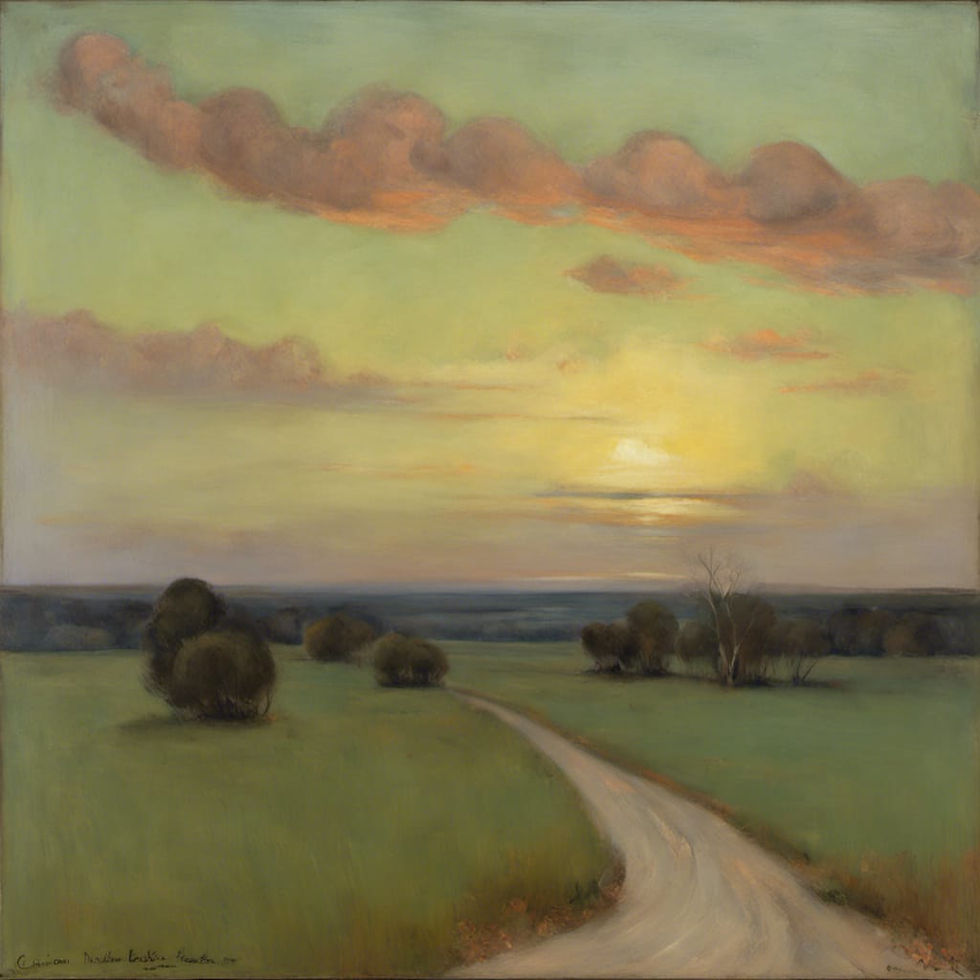Artist Spotlight #159 - Clarice Beckett
- Locutus

- Oct 26, 2024
- 4 min read
October 26, 2024

Editor's note: These artist spotlights are part of a series of posts examining the intersection of AI with art. They include a brief summary of the artist generated by AI (but also checked for accuracy by a human) and images generated by AI "in the style" of the artist. They do NOT include actual images by the artist (other websites already do this much better than I could).
Clarice Beckett (1887 - 1935)
Clarice Beckett was an Australian painter celebrated for her atmospheric landscapes and urban scenes, which capture the transient effects of light and weather with remarkable subtlety. Working in relative isolation from the mainstream art community, Beckett developed a distinctive, evocative style that emphasized mood over detail, establishing her as a unique voice in Australian modernism.
Early Life
Clarice Beckett was born on March 21, 1887, in Casterton, Victoria, Australia. She was the eldest of two children in a conservative family, which placed restrictions on her artistic pursuits. After completing her schooling, she moved to Melbourne, where she enrolled at the National Gallery School, studying under Frederick McCubbin. However, Beckett’s true stylistic influence came from her subsequent studies with Max Meldrum, an Australian Tonalist painter. Meldrum’s emphasis on tonal painting and capturing light and atmosphere through a limited color palette deeply influenced Beckett’s approach, although she soon adapted his teachings to suit her own sensibilities.
Artistic Style
Beckett’s artistic style is best described as tonal impressionism, with a focus on capturing the fleeting qualities of light and the emotive potential of ordinary scenes. Her works typically feature soft, diffused forms and subtle color shifts, eschewing precise detail in favor of mood and atmosphere. Beckett often painted en plein air, observing the landscapes and coastal scenes around Melbourne in the early morning or at dusk to capture the ephemeral effects of light and shadow. This approach allowed her to depict the natural world with a sense of intimacy and immediacy, inviting viewers into her quiet, contemplative vision of the world.
In her paintings, Beckett used a restrained, earthy palette and minimal brushstrokes, allowing shapes to emerge gradually from the canvas in misty, dreamlike forms. Her style emphasizes tonal harmony, achieved through blending and layering of colors to create a sense of softness. This approach reflected her commitment to painting what she saw rather than what she knew, presenting the world through a lens that emphasized light over form and mood over meticulous accuracy. Beckett’s style was largely underappreciated in her time, as it diverged from both the vibrant colors of Impressionism and the sharp forms of emerging modernist movements.

Notable Works
Some of Clarice Beckett’s most significant works include:
"The Motorist" (c. 1930): This painting is one of her best-known works, capturing a solitary car on a misty road. The restrained tones and blurred outlines evoke a sense of solitude and the quiet mystery of twilight, a recurring theme in her work.
"Wet Evening, Brighton" (c. 1927): In this piece, Beckett captures the shimmering reflections of street lamps on rain-soaked pavement, showcasing her skill at portraying urban scenes with a moody, contemplative quality.
"Beach Scene, Beaumaris" (c. 1925): This coastal painting, with its soft hues and gentle depiction of waves, exemplifies Beckett’s mastery of tonal impressionism. The work’s simplicity and calm evoke the atmosphere of early morning light over the water.
Legacy
Clarice Beckett passed away at age 48 on July 7, 1935, from pneumonia, having been exposed to harsh weather while painting outdoors. Her life was one of dedication to her art despite significant personal and societal obstacles. Following her death, much of her work was neglected and stored poorly, with many pieces lost or damaged. Her legacy began to be revived in the late 20th century, largely due to the efforts of art historian Rosalind Hollinrake, who rediscovered and championed Beckett’s work, bringing her remarkable contributions to the forefront of Australian art history.
Today, Beckett is celebrated as a pioneer of Australian modernism, and her work is considered an early example of minimalist landscape painting. Her ability to capture the ethereal beauty of everyday scenes has gained her a posthumous reputation as one of Australia’s most significant landscape artists. Her paintings now reside in major collections, symbolizing the quiet power of her vision and her influence on later generations of artists who sought to express mood, light, and atmosphere in similarly understated yet profound ways.
This summary was written by The Artist Biography Writer, a GPT created by the editor in ChatGPT on October 26th, 2024. A human double-checked the factual assertions.
How well does AI "interpret" Clarice Beckett?
Using "in the style of Clarice Beckett" to create AI-Assisted images will likely produce variable results, many of which will bear little resemblance to Clarice Beckett's works. At this time, SDXL 1.0 performs reasonably well at capturing Beckett's style. Using "Australian Tonalism" as an additional modifier has a tendency to produce a landscape featuring fields and a dirt road. Using "tonal impressionism" can produce some lovely results, too.




Comments